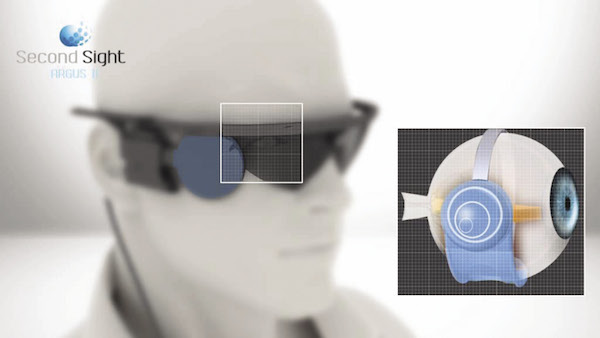The Bionic Eye is today a reality: it is an electronic device which can in specific cases restore some visual perception. The implant procedure can be done only in certain cases (such as in the presence of advanced-stage retinitis pigmentosa) and some conditions have to be respected, including the integrity of the optic nerve. The vision that can be obtained concerns the central part of the visual field. Images appear in continuous flashes and consist of numerous pixels in black and white, like a mosaic of shades of grey.
To learn more about the practical implications relating to the autonomy of persons with vision loss who undergo this type of intervention, we interviewed Dr. Marco Fossati, head of Italy's orientation and mobility rehabilitation and personal autonomy program for patients who have received the Argus II implant.
The Argus II system works by converting images captured by a small camera, mounted on the patient's glasses, in a series of small electrical pulses transmitted with a wireless system to a matrix of electrodes positioned on the retina. These pulses stimulate the retinal cells that are still functioning, translating images into a perception by the brain of luminous forms.
Patients learn to interpret these forms, recovering some visual function.
"In the physiological mechanism of vision," said Fossati "what the patient perceives is placed in a cognitive and environmental context which gives meaning to images, allowing the discrimination of large letters, domestic settings and urban environments. It is possible to perceive light, shadows and passages, lines drawn on the asphalt, pedestrian crossings, road markings, street curbs, building corners, gaps between buildings or trees, as well as the shapes of streetlights or people. Every patient I met in rehabilitation had had vision before and kept their memories alive and vivid."
An adequate rehabilitation training is therefore important to make the most of this sensory information. "Through rehabilitation, the functional use of this visual input is improved, allowing for easier and more independent mobility," says Dr. Fossati. "The system works well in combination with a white cane or a guide dog alternating information, stimulation and protection."
One of the skills that people come to experience is anticipating and estimating the distances between them and an object.
Finally, we observed that for some people, maintaining active the visual channel helps improve independent and more enjoyable mobility.





.png)